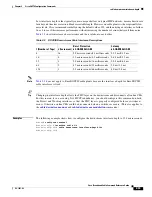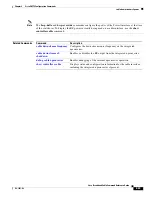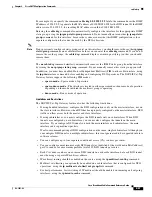
2-56
Cisco Broadband Cable Command Reference Guide
OL-1581-08
Chapter 2 Cisco CMTS Configuration Commands
cable downstream modulation
cable downstream modulation
To set the modulation format for a downstream port on a cable interface line card, use the
cable
downstream modulation
command in cable interface configuration mode.
cable downstream modulation
{
64qam
|
256qam
}
Syntax Description
Defaults
64qam
Command Modes
Interface configuration (cable interface only)
Command History
Usage Guidelines
Downstream modulation defines the speed in bits per second at which data travels downstream to the
subscriber’s CM. A symbol is the basic unit of modulation. QPSK encodes 2 bits per symbol, 16-QAM
encodes 4 bits per symbol, 64-QAM encodes 6 bits per symbol, and 256-QAM encodes 8 bits per
symbol.
Note
Setting a downstream modulation format of 256-QAM requires approximately a 6-dB higher signal-to-
noise ratio (SNR) than 64-QAM at the subscriber’s cable modem. If your network is marginal or
unreliable at 256-QAM, use the 64-QAM format instead.
Tip
Changing the modulation format affects the PHY layer on the downstream and disconnects all online
CMs. For this reason, if you are using N+1 HCCP redundancy, you should configure this command on
both the Protect and Working interfaces, so that the PHY layer is properly configured before a
switchover occurs. Otherwise, online CMs could be disconnected when a switchover occurs. (This also
applies to the
cable downstream annex
and
cable downstream interleave-depth
commands.)
Examples
The following example shows how to set the downstream modulation to 256-QAM:
Router#
configure terminal
Router(config)#
interface cable 3/0
Router(config-if)#
cable downstream modulation 256qam
Router(config-if)#
64qam
Modulation rate is 6 bits per downstream symbol.
256qam
Modulation rate is 8 bits per downstream symbol.
Release
Modification
11.3 XA
This command was introduced.
















































